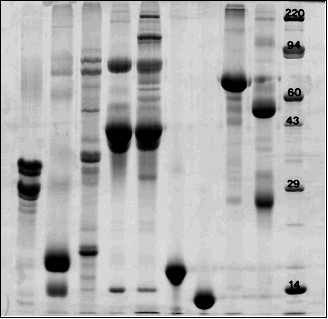
Comparative Analysis of Western Blotting for Phosphorylated Proteins vs. Mass Spectrometry and Immunoprecipitation
Protein analysis is a crucial component of modern molecular biology and biochemistry research. Understanding the post-translational modifications (PTMs) of proteins is especially important, as PTMs can greatly influence protein function and cellular processes. In this article, we will delve into the comparative analysis of Western blotting for phosphorylated proteins, mass spectrometry, and immunoprecipitation as methods for studying protein phosphorylation. Each of these techniques has its own strengths and limitations, and choosing the right one depends on the specific research objectives and resources available.
Western Blotting for Phosphorylated Proteins: Western blotting, also known as immunoblotting, is a widely used technique for detecting and quantifying specific proteins in a complex mixture. When it comes to phosphorylated proteins, Western blotting offers several advantages:
Specificity: Western blotting allows for the precise detection of phosphorylated proteins using phospho-specific antibodies. These antibodies are designed to recognize and bind only to proteins with specific phosphorylation sites, ensuring high specificity.
Quantification: Densitometry analysis of Western blots provides semi-quantitative data on the levels of phosphorylated proteins. While not as precise as mass spectrometry, it can be sufficient for many research questions.
Simplicity: Compared to mass spectrometry, Western blotting is relatively straightforward and does not require specialized instrumentation or extensive training. Many researchers are familiar with this technique.
Cost-Effectiveness: Western blotting is generally more cost-effective than mass spectrometry. The reagents and equipment required for Western blotting are widely available and less expensive.
However, Western blotting for phosphorylated proteins has its limitations:
Limited Multiplexing: Western blotting is typically limited to the detection of one or a few phosphorylated proteins at a time, making it less suitable for large-scale studies.
Semi-Quantitative: The quantification obtained from Western blotting is semi-quantitative and may not provide absolute protein quantification.
Protein Identification: Western blotting primarily identifies known phosphorylated proteins. It may not be suitable for discovering novel phosphorylation events.
Mass Spectrometry: Mass spectrometry is a powerful analytical technique for identifying and quantifying proteins and their PTMs, including phosphorylation. Here are some key advantages of mass spectrometry:
High Throughput: Mass spectrometry can analyze a large number of proteins and PTMs simultaneously, making it ideal for global phosphoproteomic studies.
Quantitative Accuracy: Mass spectrometry provides accurate quantitative data, allowing for the precise measurement of protein phosphorylation levels.
Comprehensive Analysis: Mass spectrometry can identify novel phosphorylation sites and proteins, making it a valuable tool for discovery-based research.
Sensitivity: Mass spectrometry is highly sensitive and can detect low-abundance phosphorylated proteins.
However, mass spectrometry also has some drawbacks:
Complexity: It requires specialized equipment and expertise in sample preparation, data analysis, and instrument operation.
Cost: The cost of mass spectrometry instruments and consumables can be prohibitively high for some research groups.
Sample Size: Mass spectrometry requires relatively large sample quantities, which can be a limitation when working with limited biological samples.
Immunoprecipitation: Immunoprecipitation (IP) is a technique used to selectively isolate a specific protein or protein complex from a mixture. It can be combined with Western blotting or mass spectrometry to study phosphorylated proteins. Here’s how immunoprecipitation compares:
Selectivity: IP allows for the selective isolation of phosphorylated proteins or protein complexes using specific antibodies, similar to Western blotting.
Compatibility: IP can be combined with Western blotting or mass spectrometry to analyze the phosphorylation status of immunoprecipitated proteins.
Specificity: IP provides high specificity when using antibodies targeting phosphorylated epitopes.
However, immunoprecipitation has its limitations:
Sample Loss: During the IP process, some target proteins may be lost, leading to reduced sensitivity.
Labor-Intensive: IP can be a time-consuming process, especially when working with multiple samples.
3.6. Non-Quantitative: IP itself does not provide quantitative data; additional assays like Western blotting or mass spectrometry are needed for quantification.
Choosing the Right Method: The choice between Western blotting, mass spectrometry, and immunoprecipitation for studying phosphorylated proteins depends on various factors:
Research Objectives: Consider whether you need to analyze one or a few specific phosphorylated proteins (Western blotting), conduct large-scale phosphoproteomic studies (mass spectrometry), or selectively isolate phosphorylated proteins (immunoprecipitation).
Resources: Evaluate your lab’s equipment, expertise, and budget. Mass spectrometry is resource-intensive, while Western blotting is more accessible.
Sensitivity and Specificity: Consider the sensitivity and specificity requirements of your experiment. Mass spectrometry is highly sensitive and specific, while Western blotting and immunoprecipitation offer intermediate levels.
Sample Availability: Assess the quantity and quality of your biological samples. Mass spectrometry may require larger sample amounts.
Timeframe: Think about your project timeline. Western blotting and immunoprecipitation are quicker to set up, while mass spectrometry workflows are more time-consuming.
Data Analysis: Consider your data analysis capabilities. Mass spectrometry data analysis can be complex and may require bioinformatics expertise.
Complementary Approaches: In many cases, researchers use a combination of these techniques to gain a more comprehensive understanding of phosphorylation events. For example:
Western Blotting and Mass Spectrometry: Researchers often perform Western blotting to validate mass spectrometry results, confirming the presence of specific phosphorylated proteins.
Immunoprecipitation and Mass Spectrometry: Immunoprecipitation can be used to enrich specific phosphorylated proteins, which are then subjected to mass spectrometry for in-depth analysis.
Western Blotting and Immunoprecipitation: Western blotting can validate immunoprecipitation results and provide semi-quantitative data on phosphorylation levels.
Conclusion: In summary, the choice between Western blotting, mass spectrometry, and immunoprecipitation for studying phosphorylated proteins depends on the specific research goals, available resources, and experimental requirements. Each method has its own strengths and limitations, and researchers often use a combination of these techniques to obtain a more comprehensive view of phosphorylation events. Ultimately, selecting the most appropriate method is essential for generating meaningful and reliable data in the field of protein phosphorylation analysis.


